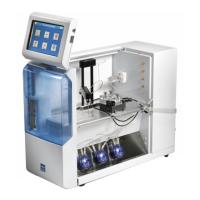117
8.2.16 Simultaneous Glucose and Sucrose
Refer to the sections above on Glucose and Sucrose for theoretical and special considerations. Then follow the
instructions below to set up your instrument for simultaneous determination.
Buffer
Std
Conc.
Note: See Appendix B – Concentration
Unit Conversion if concentration unit
conversion is required.
Since the Sucrose Membrane (2703) utilizes a chain of enzyme
reactions and the final reaction is a “glucose measurement”, free
glucose in a sample will be measured at the Sucrose Sensor. By
using the information at the Glucose Sensor, this free glucose is
automatically subtracted in the instrument software. The
algorithm looks basically like this:
(“Total Glucose” - “Free Glucose”) x (1.9) = Sucrose
Total Glucose is the combined sucrose and glucose probe signal.
Free Glucose is the glucose not derived from sucrose hydrolysis.
The constant 1.9 corrects for the weight of fructose that is not
sensed at either probe, and the water of hydrolysis.
Sucrose Specifications:
When simultaneously measuring glucose and sucrose, the
sucrose precision and linearity are as follows:
Precision (CV,n=10): 4% or 0.04 g/L, whichever is greater
Linearity: ±5%
Special Considerations:
• When measuring glucose and sucrose, the glucose and
sucrose sensors must be located in the same module.
The combined total of glucose + sucrose cannot exceed 25 g/L.
The glucose concentration cannot exceed 10 g/L if the combined
total is near 25 g/L, since a glucose concentration that high
combined with 15 g/L sucrose will saturate the Sucrose probe. If
either of these conditions occur, you should dilute your sample to
bring it into a reasonable range.
The ability to select sample size (10 to 50 µL) may help you
optimize your system, especially if very high or very low
concentrations of one or the other of these substrates is a
problem. The optimal probe current for a calibrator is about 10
nA. See 4.11 Check Probe Currents , to learn more about
measuring your probe signal.
If the glucose concentration in your sample exceeds the sucrose
concentration, the subtraction of a large glucose “signal” from a
smaller sucrose “signal” may result in significant errors in the
sucrose reading. An alternative method involves using two
different, and appropriate dilutions of the sample to first measure
free glucose, then treat one sample with invertase and analyze
for glucose liberated from the sucrose. Contact YSI Technical
Support or your dealer representative for an application note
explaining this approach in detail.

